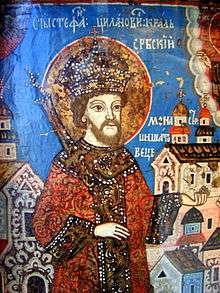Paštrovići
The Paštrovići (Serbian Cyrillic: Паштровићи, pronounced [pâʃtrɔʋitɕi], Italian: Pastrouichi, Pastrouicchi) is a historical tribe and region in the Montenegrin Littoral. Paštrovići stretches from the southernmost part of the Bay of Kotor, from the cape of Zavala to Spič.[1] Paštrovići was a province of Venetian Albania, a Venetian possession on the Adriatic coast, from 1423 until 1797, with interruptions by the Ottoman Empire. It was part of the Kingdom of Dalmatia from 1815 to 1918, then Yugoslavia, then became part of Montenegro only after World War II. It is historically one of two major "maritime tribes", the other being Grbalj.
History
The etymology of the name Paštrovići is unclear.[1] The JAZU derives it from the given names Paštro, Paštroje, meaning "a colorful man".[1] There are also theories that it derives from Albanian pastër, meaning "clean", or Latin pastor, meaning "shepherd" (supported by S. Ćirković[2]).[1] The name is first attested in a text dating to 1355,[1][3] regarding nobleman Nikolica Paštrović in the service of Serbian emperor Stefan Dušan (r. 1331–55), sent to the Republic of Ragusa.[4] In 1363, Radak Paštrović donated to a church in Rac.[3] Since 1377 they are regularly mentioned in Ragusan documents.[3] In March 1399, several "people from Paštrovići" are mentioned.[3] Originally a family, it would expand into a tribe by the first half of the 15th century.
During the Zetan–Venetian First Scutari War (1405–13) they were under control of the related Đurašević family whose members held the most prestigious positions on the court of Balša III.[5] In the Serbian–Venetian Second Scutari War (1419–23) they at first served the Serbian Despotate, until January 1423 when the Republic of Venice managed to bribe them and other tribes in the region over to the Venetian side.[6] Though none of these were mobilized militarly, they left the Serbian ranks and thus became potential danger to Despot Stefan Lazarević.[6] The Paštrović assembly agreed to enter the service of Venice in April 1423, accepting Venetian suzerainty and taxes; in return they received promise to respect their tribal institution, guarantees of their present lands and recognition of their right to lost lands.[6] Peace was signed in August 1423.[7]
Thus, by this 1423 treaty, the province of Paštrovići received an autonomous status, while the brotherhoods (families) of Paštrovići became a "tribe", building their free villager estate and internal self-government with kinship organization – becoming petty nobility.[8]
In the 1582–83 Ottoman defter (tax registry) of the Montenegro Vilayet, an autonomous province of the Sanjak of Scutari, Paštrovići was one of nine nahiya, with 36 villages (out of a total of 148 in the vilayet).[9] In 1592–93, Derviš-beg Alić Sarvanović, the sanjak-bey of Montenegro, also held Paštrovići and Perast.[10]
Paštrovići were the part of Republic of Venice until the fall of Venice in 1797.
Culture
Paštrovići is traditionally Orthodox Christian.[1]
Anthropology
Families
Novaković, Paštar, Bečići, Čučuci, Gracuni, Klapavice, Kalađurđevići, Dabkovići, Kuljače, Kentere, Kažanegre, Balići, Mitrovići, Grlomani, Anđusi, Despotovići, Đuraševići, Sankovići, Jovanovići, Rađenovići, Luketići, Vojnići, Rafailovići, Markićevići, Divanovići, Goliši, Ljubiše, Niklanovići, Krute, Radovići, Vukovići, Sklenderi, Pavlovići, Kaloštrovići, Đedovići, Đakonovići, Zenovići, Perazići, Bosnići, Franovići, Franićevići, Srzentići, Davidovići, Mikovići, Medigovići, Gregovići, Androvići, Radanovići, Šoljage, Vukotići, Suđići, Andrići, Midžori, Todorice, Armenci, Medini, Milutinovići, Draškovići, Živkovići, Perovići, Mainići, Vukmirovići.
Notable people

- Stefan Štiljanović, Hungarian nobleman, proclaimed Serbian saint
- Stefan Paštrović, 16th-century publisher of the earliest Serbian primer
- Stefano Zannowich, Serbian writer and adventurer
- Stjepan Mitrov Ljubiša, a writer
- Visarion Ljubiša, Metropolitan of Montenegro
- Rade Andrović, a national hero
- Borko Paštrović, Serbian Chetnik commander during the First Balkan War
References
- 1 2 3 4 5 6 Gregović 2010.
- ↑ Ćirković, Sima (2008). The Serb. John Wiley & Sons. p. 130. ISBN 9781405142915.
- 1 2 3 4 Вукмановић 1960, p. 9.
- ↑ Вукмановић 1960, p. 126.
- ↑ Fine 1994, pp. 512–513.
- 1 2 3 Fine 1994, p. 517.
- ↑ Fine 1994, p. 519.
- ↑ Čubrilović 1983, p. 414.
- ↑ Vasić, Milan (1991), "Etnički odnosi u jugoslovensko-albanskom graničnom području prema popisnom defteru sandžaka Skadar iz 1582/83. godine", Stanovništvo slovenskog porijekla u Albaniji : zbornik radova sa međunarodnog naučnog skupa održanog u Cetinju 21, 22. i 23. juna 1990 (in Serbo-Croatian), OCLC 29549273
- ↑ Branislav Đurđev (1953). Turska vlast u Crnoj Gori.
Године 1592 успео је Пећанац Дервиш-бег Алић Сарвановић да добије Црногорски санџак који је са Улцињем и Баром из- двојен из Скадарског санџака. Нови санџак-бег је писао котор- ском провидуру да је добио на управу Црногорски санџак и са и.им Паштровиће и Пераст који су били под млетачком влашћу. Он је у том писму захтевао да му дођу Паштровићи и Пераштани и ...
Sources
- Čubrilović, Vasa (1983). Odabrani istorijski radovi. Narodna knjiga.
- Fine, John Van Antwerp, Jr. (1994). The Late Medieval Balkans: A Critical Survey from the Late Twelfth Century to the Ottoman Conquest. University of Michigan Press. ISBN 978-0-472-08260-5.
- Gregović, Đorđe V. (2010). "О ПАШТРОВИЋИМА". Rastko.
- Kostić, Lazo M. (1961). O srpskom karakteru Boke Kotorske. Izdan'e piščevo.
- Petrović, Mihailo (1941). Đerdapski ribolovi u prošlosti i u sadašnjosti. 39. Izd. Zadužbine Mikh. R. Radivojeviča. p. 198.
- Stanojević, Stanoje (1928). "Narodna enciklopedija srpsko-hrvatsko-slovenačka" (PDF). 3: 357.
Paštrovići
- Вукмановић, Jован (1960). Паштровићи: антропогеографско-етнолошка испитивања. Obod.
